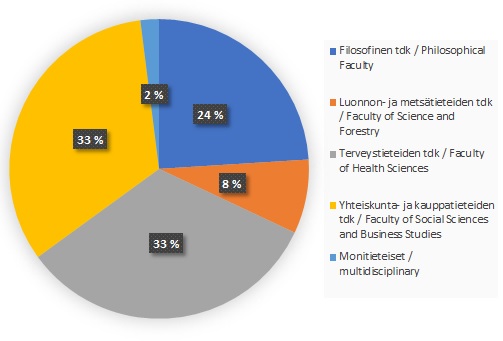591 250 €
(Please, scroll down to read in English.)
Mikä 591 250 €? Se on summa, jonka Itä-Suomen yliopiston kirjasto käytti kirjojen hankintaan vuonna 2019. Siihen sisältyvät pysyvästi kokoelmiin hankittujen kirjojen ostot, e-kirjojen lainauskertojen ostot sekä e-kirjojen ja sähköisten hakuteosten ja sanakirjojen vuositilaukset.
Pysyväisostojen sekä lainauskertojen ostojen osuus kirjahankintojen arvosta oli 58 %, vuositilausten osuus 42 %. Sähköisen formaatin osuus oli 71 %, painetun 29 %.
Tiedekunnittain tarkasteltuna filosofisen tdk:n alojen osuus kirjahankinnoista oli 24 % (sähköinen 61 %, painettu 39 %), luonnontieteiden ja metsätieteiden tdk:n alojen osuus 8 % (sähköinen 66 %, painettu 34 %), terveystieteiden tdk:n alojen osuus 33 % (sähköinen 85 %, painettu 15 %), yhteiskuntatieteiden ja kauppatieteiden tdk:n alojen osuus 33 % (sähköinen 67 %, painettu 33 %) ja monitieteisten aineistojen osuus 2 % (sähköinen 55 %, painettu 45 %).
Lukuja tarkasteltaessa on huomioitava, että jotkut vuositilauksina hankittavista hakuteoksista ovat käyttöliittymältään kaukana perinteisestä kirjasta. Tällaisia aineistoja – jotka voisi luokitella myös tietokannoiksi tai portaalisivustoiksi – sisältyy erityisesti terveystieteiden lukuihin.
Pysyvästi kokoelmiin ostettiin painettuja ja e-kirjoja 343 758 €:lla. Tästä tutkimuskirjojen osuus oli 65 % ja kurssikirjojen osuus 35 %.
Pysyväisostojen jakautuminen tiedekunnittain:
- Tutkimuskirjat: filosofinen tdk 35 %, luonnontieteiden ja metsätieteiden tdk 9 %, terveystieteiden tdk 4 %, yhteiskuntatieteiden ja kauppatieteiden tdk 51 %, monitieteiset 2 %
- Kurssikirjat: filosofinen tdk 36 %, luonnontieteiden ja metsätieteiden tdk 4 %, terveystieteiden tdk 28 %, yhteiskuntatieteiden ja kauppatieteiden tdk 32 %
Pysyväisostojen jakautuminen formaateittain:
- Tutkimuskirjat, sähköiset 37 %
- Tutkimuskirjat, painetut 28 %
- Kurssikirjat, sähköiset 12 %
- Kurssikirjat, painetut 22 %
- Erottelemattomat sähköiset 1 %
On muistettava, että kurssikirjallisuutta sisältyy myös vuositilauksina hankittuihin aineistoihin. Näissä erottelua tutkimuskirjoihin ja kurssikirjoihin ei kuitenkaan pystytä tekemään samalla tavalla kuin pysyvästi ostettujen kirjojen kohdalla.

What EUR 591,250? That is the sum that the University of Eastern Finland’s library spent on the acquisition of new books in 2019. It includes the purchase of books that were acquired for collections permanently, the purchase of e-book loans and the annual subscriptions for electronic reference books and dictionaries.
Permanent purchases and the purchase of loans accounted for 58% of library acquisitions, while annual subscriptions accounted for 42%. 71% of the material was electronic, while 29% was printed.
Broken down by faculty, the Philosophical Faculty’s share of the book acquisitions was 24% (61% electronic, 39% printed), the Faculty of Science and Forestry’s share was 8% (66% electronic, 34% printed), the Faculty of Health Sciences’ share was 33% (85% electronic, 15% printed), the Faculty of Social Sciences and Business Studies’ share was 33% (67% electronic, 33% printed) and multidisciplinary material accounted for 2% (55% electronic, 45% printed).
When examining the figures, it should be noted that some of the reference books acquired with annual subscriptions are far-removed from traditional books in regard to their user interfaces. Such material – which could also be classified as databases or online portals – is included in the Faculty of Health Sciences’ figures in particular.
A total of EUR 343,758 was spent on printed books and e-books purchased to permanently add to collections. Of these, research books accounted for 65% while course books accounted for 35%.
The distribution of permanent purchases by faculty:
- Research books: Philosophical Faculty 35%, Faculty of Science and Forestry 9%, Faculty of Health Sciences 4%, Faculty of Social Sciences and Business Studies 51%, multidisciplinary 2%
- Course books: Philosophical Faculty 36%, Faculty of Science and Forestry 4%, Faculty of Health Sciences 28%, Faculty of Social Sciences and Business Studies 32%
The distribution of permanent purchases by format:
- Research books, electronic 37%
- Research books, printed 28%
- Course books, electronic 12%
- Course books, printed 22%
- Indeterminate electronic 1%
It should be noted that course literature is also included in the material acquired as annual subscriptions. This type of material cannot be separated into research books and course books in the same ways as permanently purchased books.
Mikko Meriläinen, tietoasiantuntija | information specialist
Tietoaineistopalvelut | Collection services